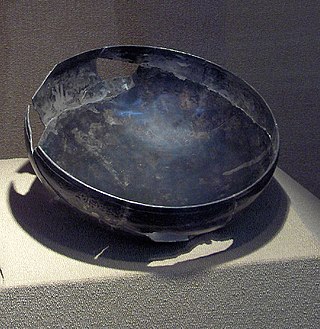Biography
Reign
There are only a few scattered sources left that describe the reign of Hantili. [5] During his reign, he continued the militaristic traditions of the kings before him. One of Hantili's main concerns was maintaining Hittite control in Syria. He journeyed to the city of Carchemish to conduct a military campaign, most likely against the Hurrians, [6] longtime enemies of the Hittites. The success of this campaign is unknown.
After the conclusion of this campaign, he made his return journey to Hattusa, the Hittite capital. While on this journey, he reached the city of Tegarama, which is possibly the modern-day Turkish city of Gürün. At this point, the Telepinu Proclamation states that Hantili started to regret that he had killed Mursili, saying to himself, "What is this (that) I have done? [Why] did I listen to [the words of] Zidanta, my [son-in-law]? As soon as] he reigned [as king], the gods sought (justice for) the blood of Muršili." [7]

The Hittites were an Anatolian Indo-European people who formed one of the first major civilizations of Bronze Age West Asia. Possibly originating from beyond the Black Sea, they settled in modern-day Turkey in the early 2nd millennium BC. The Hittites formed a series of polities in north-central Anatolia, including the kingdom of Kussara, the Kanesh or Nesha kingdom, and an empire centered on Hattusa. Known in modern times as the Hittite Empire, it reached its peak during the mid-14th century BC under Šuppiluliuma I, when it encompassed most of Anatolia and parts of the northern Levant and Upper Mesopotamia, bordering the rival empires of the Hurri-Mitanni and Assyrians.

Šuppiluliuma I, also Suppiluliuma or Suppiluliumas was an ancient Hittite king.
Mursili I was a king of the Hittites c. 1620-1590 BC, as per the middle chronology, the most accepted chronology in our times, and was likely a grandson of his predecessor, Hattusili I. His sister was Ḫarapšili and his wife was queen Kali.
Tudḫaliya I was a Hittite great king in the 15th century BC, ruling perhaps c. 1465–c. 1440 BC

Šuppiluliuma II, the son of Tudḫaliya IV, was the last certain great king of the New Kingdom of the Hittite Empire, contemporary with Tukulti-Ninurta I of the Middle Assyrian Empire. His reign began around 1207 BC and ended at an unknown later date.
Mursili II was a king of the Hittite Empire c. 1330–1295 BC or 1321–1295 BC.
Arnuwanda II was a Hittite great king who reigned in the late 14th century BC, perhaps in c. 1322–1321 BC. His reign was a briefly interlude between those of his father Šuppiluliuma I and younger brother Muršili II.
Tudḫaliya II was a Hittite great king in the late 15th/early 14th century BC, ruling in perhaps c. 1425–c. 1390 BC. He was the father-in-law and predecessor of Arnuwanda I.

Labarna was the traditional first king of the Hittites, c. early 17th century BC, the most accepted chronology nowadays. He was the traditional founder of the Hittite Old Kingdom. His wife was Tawannanna.

Hattusili I was a king of the Hittite Old Kingdom. He reigned ca. 1650–1620 BC, or ca. 1640–1610 BC.
Ammuna was a King of the Hittites ca. 1550–1530 BC or 1486–1466 BC. The land seems to have suffered badly during his reign, and he lost a considerable amount of territory.
Telipinu was the last king of the Hittites Old Kingdom, reigning c. 1525–1500 BC in middle chronology. At the beginning of his reign, the Hittite Empire had contracted to its core territories, having long since lost all of its conquests, made in the former era under Hattusili I and Mursili I – to Arzawa in the West, Mitanni in the East, the Kaskians in the North, and Kizzuwatna in the South.

Tudḫaliya III, with the additional Hurrian name Tašmi-Šarri, was a Hittite great king in Anatolia during the Late Bronze in the 14th century BC, in c. 1380–1350 BC. He was the son and successor of Arnuwanda I and the predecessor, father-in-law, and adoptive father of Šuppiluliuma I.
Zidanta I was a king of the Hittites, ruling for 10 years, ca. 1560–1550 BC or 1496–1486 BC. According to the Telepinu Proclamation, this king became a ruler by murder.
Huzziya I was a king of the Hittites, ruling for 5 years, ca. 1530–1525 BC or 1466–1461 BC.
Tahurwaili was a king of the Hittites, c. early 15th century BC or mid 15th century BC. He was a cousin of the King Telipinu.
Zidanta II was a king of the Hittites in the 15th century BC.

Ḫarapšili was a Hittite queen during the Old Kingdom of Hittites.

The Yamhad dynasty was an ancient Amorite royal family founded in c. 1810 BC by Sumu-Epuh of Yamhad who had his capital in the city of Aleppo. Started as a local dynasty, the family expanded its influence through the actions of its energetic ruler Yarim-Lim I who turned it into the most influential family in the Levant through both diplomatic and military tools. At its height the dynasty controlled most of northern Syria and the modern Turkish province of Hatay with a cadet branch ruling in the city of Alalakh.
This page is based on this
Wikipedia article Text is available under the
CC BY-SA 4.0 license; additional terms may apply.
Images, videos and audio are available under their respective licenses.








